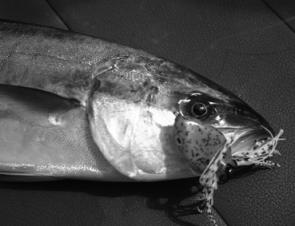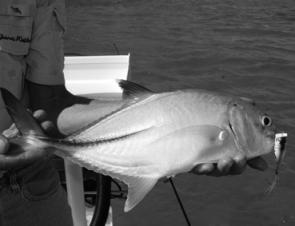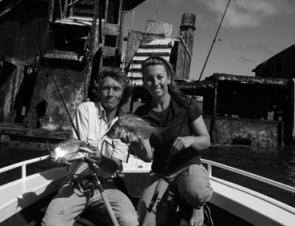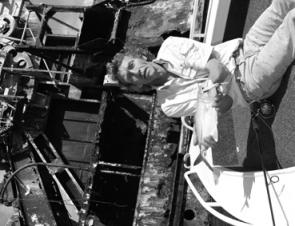Having grown up on the waters of Moreton Bay there are many spots that bring back wonderful memories. I’ve written about a few of them over the recent years.
An iconic location in my catalogue of great places to wet a line is the Tangalooma Wrecks, a line of hulks scuttled in a row to form an anchorage.
When I was eight we spent the first of many summer holidays camped on Moreton Island near the Tangalooma Anchorage. Our morning routine often consisted of a quick ‘lap’ around The Wrecks before breakfast. We’d start at the southern end and catch a kingie or two on 4 or 6kg spin gear. With most of the kings reaching 3kg we usually stood a chance. Then we’d scale down to 2kg lurecasting spin sticks to target big-eye trevally on poppers. We’d cap off the morning feed for breakfast with a bream or two using 1kg sportfishing outfits, or sometimes the 2kg outfits with the trevally poppers if we wanted to use ‘heavy’ tackle. On a good morning we’d have a selection of fresh fish for breakfast, and other days the fishing was so good that we forgot about breakfast all together.
Crystal clear waters, white sandy beaches and lots of fish are the visions that fill my mind when I think of Tangas. The species that I’ve caught most commonly include bream, trevally and yellowtail kingfish. I have also taken the occasional reef species over the years.
I recall fishing Tangalooma Wrecks with poppers when I still counted my age in single figures. Having just celebrated my 26th birthday with family and friends in the very same spot, I’ve got around twenty years of fishing The Wrecks under my belt.
Kings were the glamour fish when I was a kid. Sure you could hook them, but extracting them wasn’t easy. The yellowtail kingfish ranked number one in my books because their strike was exciting especially on poppers, and you never knew who would win the often short-lived battle. A perfect kid’s fish.
The most reliable approach to catching a kingie on a popper is to stand a full casting distance off from the southernmost wreck. Pepper casts around the tail of the last wreck for the best results. Over the years we’ve caught more fish by working poppers and other surface lures along the outside rather than the inside, but the inside still works.
Sometimes schools of predatory fish will get stuck into schools of baitfish on the western flats. These open water schools can be targeted with high-speed retrieved metal slugs or slice style lures as well as bloopers or high-speed poppers. You can also throw soft plastics, especially 5” straight-tailed shads, rigged on jigheads into the frenzy. Retrieve them with a jerk and pause cadence.
Unweighted soft plastics also work in open water situations. A single soft plastic, such as an Assassin Twitch, rigged on a Mustad Mega-Bite or Gamakatsu EWG 5/0 ‘worm’ hook are fairly inexpensive. I wish we had access to good soft plastic stickbaits when I was a line class angler all those years ago. To present your soft stickbait to the kings, cast the lure into the danger zone and skip it back across the surface using a variety of reel speed, rod flicks and pause until you find what the kings prefer on the day. If they’re about, they’ll eat them!
Yet another alternative is a lure that some might describe as a mixture between a popper and a soft plastic, the Scum Frog Popper. Recently I’ve enjoyed throwing these hollow soft plastic ‘bass’ lures to saltwater species including kings.
Trevally are less predictable and can be caught anywhere on many styles of lures, particularly those that I have already mentioned for yellowtail kings. If you catch a popper-munching critter off one of the middle wrecks then you may think it’s a trevally unless you know otherwise. Just like the kings, I’ve also caught them out on the flats when they’ve been smashing into schools of baitfish. It never hurts to try a fast trevally retrieve.
The submerged wreck at the northern end is where catches of bream most commonly occur. These fish are definitely tough adversaries in the kilo class. One very short recent wipeout session at the north end saw anglers down 3:2 against the bream. And that was just the first drift past!
If you’ve read some of my other articles on top-watering for bream, you may know that although they are often aggressive lure strikers, they will quickly spook once one of them is caught and/or you alert them to your presence by making loud noises. You can reduce the chance of this happening but you’ll never eliminate it. This holds true at The Wrecks, so when the fish do get gun shy, give the bream a break and drop a line elsewhere.
The bream honey holes at The Wrecks are the northernmost hulks. Pay particular attention to the area around the second submerged hulk on the western side at the northern end of The Wrecks, and the sandy gutter between the two northern hulks. Great bream luring can come from this particular spot and it is a safer place to drift if the wind direction and strength isn’t friendly.
I like to sort my drift path out a little with a trial first before approaching the honey hole. Once this is sorted I then idle in, cut the main engine and drift past while throwing poppers ahead of my boat. Most bream strikes will come from inside, across the top, or immediately adjacent to The Wrecks on high tide. Although it is still worth keeping an eye peeled for any school bream activity in the clear water above the sand flats within casting range of The Wrecks.
Throwing long, slender worm profile soft plastics on light jigheads can tempt a reef species or two. Cast them up current so that they sink to the base of the wreck quicker, especially in the deeper holes alongside the scuttled wrecks. The bigger fish are generally shy and the average run of fish is on the small side. Every now and then you’ll find a fish to brag about which makes it all worthwhile.
Next month I’ll cover the many access options anglers have to The Wrecks. I’ve used everything from car toppers from 4WDs, tenders from bigger boats, and trailer boats.
Reads: 14062
A kingfish caught on a Scum Frog.

Lures are ideal for targeting kingfish and trevally around The Wrecks.

The author with Moreton Bay Professional Fishing Guide Pommy Dave Clayton, known as Pommy by everybody, displaying two surface lure caught bream taken from the northern end of the Tangalooma wrecks.

More surface lure action from the Tangalooma Wrecks, this time a big-eye trevally.




